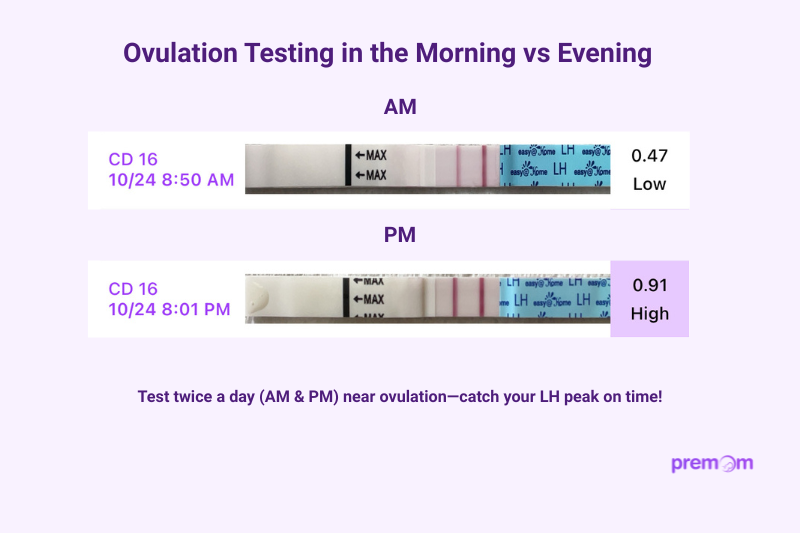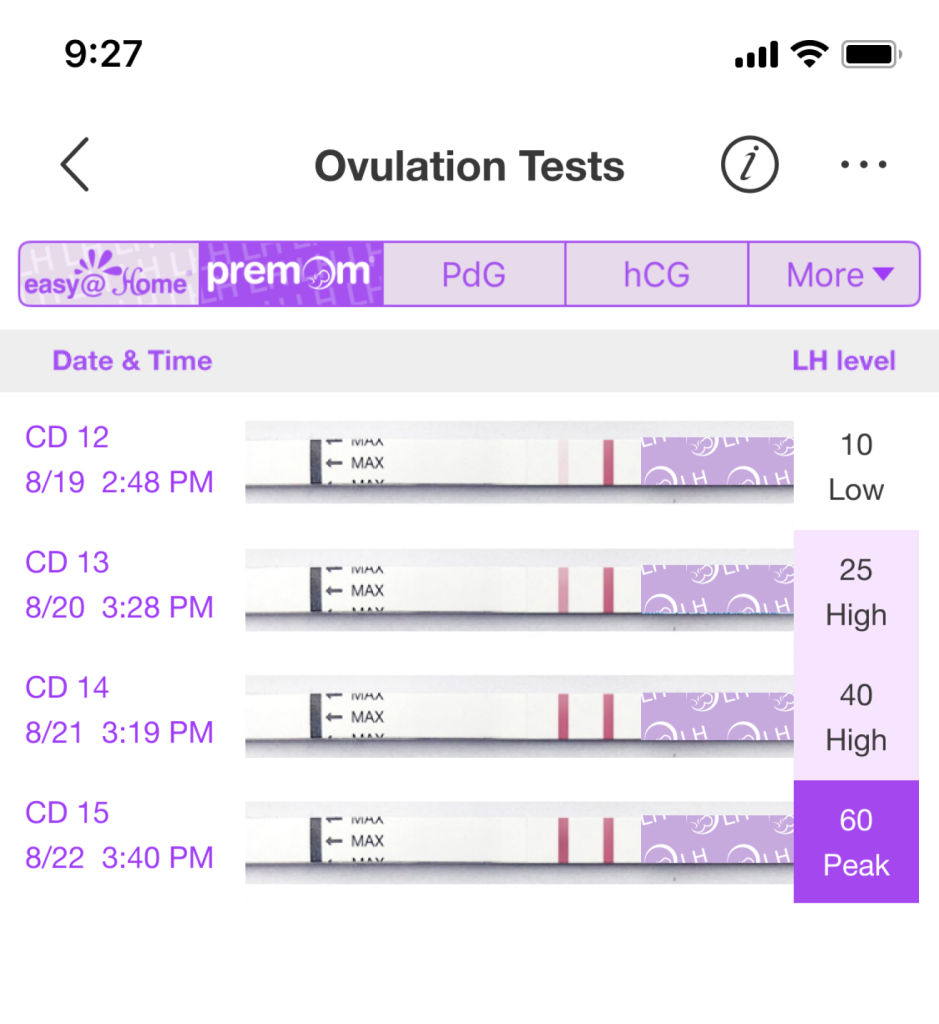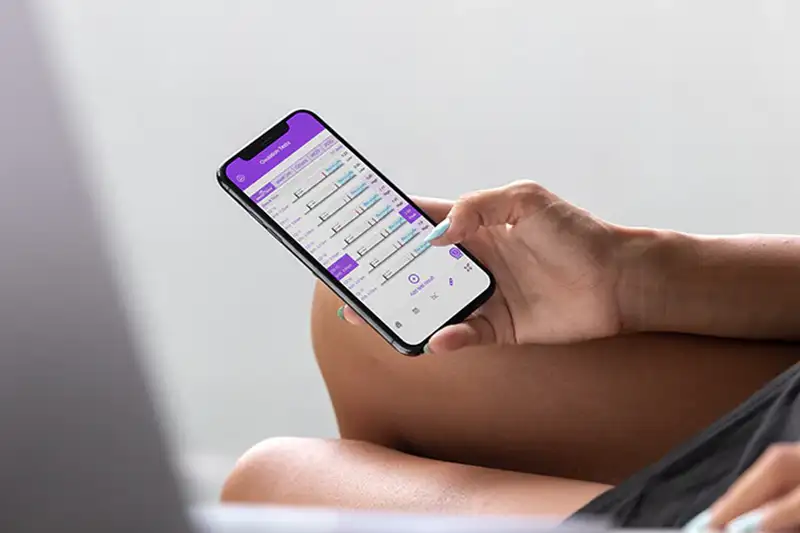If you’ve been testing for ovulation and keep seeing negative results or faint lines, you’re probably asking yourself: “Why can’t I find my LH peak? Does this mean I’m not ovulating?” First, take a deep breath because you’re absolutely not alone. Many women experience this worry, and it can feel discouraging when your tests don’t give you the clear answers you’re hoping for.
Not seeing a clear LH surge or LH peak on ovulation tests is one of the most common frustrations during a trying to conceive journey. It’s confusing, stressful, and sometimes makes you wonder if something is wrong. But the good news is that finding no LH surge doesn’t always mean you didn’t ovulate.
Sometimes, it’s about the timing of your tests, the way your body naturally produces hormones, or even how you’re interpreting the lines. Trying to conceive (TTC) is hard enough without second-guessing your body every cycle. Let’s break this down together.
Why You Might Not See an LH Peak or Surge on Your Tests
It can feel disheartening to test day after day and never see a clear positive ovulation test. But no LH surge doesn’t always mean ovulation didn’t happen. Sometimes it’s just that the surge wasn’t caught or looked different than expected. Here are some of the most common reasons why ovulation tests might not show a clear surge.
Timing issues — short surge, missed with once-daily testing
Some women experience short LH surges—sometimes called rapid-onset peaks—that rise and fall within just a few hours. If you’re only testing once a day, you could easily miss the window. For example, a surge might start in the morning, peak midday, and be back to baseline by evening.
If you’re only testing after work or before bed, you may never see that positive result, even if ovulation occurred. To improve your chances of catching your peak, test twice daily during your fertile window—once late morning and again in the afternoon or evening. Consistency matters too, so aim to test at the same times each day to make your results easier to compare.

Faint or inconsistent OPK lines
Not every LH surge looks like a bold, dark positive. Some women naturally have lower LH peaks, which means their test lines are lighter than the control line, even when ovulation is happening. This can cause unnecessary worry, especially if you’re comparing your lines to someone else’s.

Faint lines don’t always mean no LH surge. They could simply reflect your body’s unique hormone levels or the sensitivity of your test brand. Some ovulation tests also require higher thresholds to register as positive, so they may not pick up on smaller peaks. Using the Premom app helps by automatically reading your tests and charting the results, making even subtle changes easier to recognize.
Irregular or anovulatory cycles
If your cycles are irregular, ovulation may not happen consistently each month. Stress, illness, travel, thyroid conditions, or polycystic ovary syndrome (PCOS) can all make it harder to detect an LH surge. This could look like multiple small surges, no clear peak, or ovulation occurring later than expected.
While occasional irregular cycles are considered normal, consistent irregularities may mean your body isn’t ovulating regularly. If this happens for several cycles in a row, it’s worth bringing it up to your doctor. They may suggest bloodwork, ultrasound, or other hormone testing to provide clarity.
PCOS or hormone imbalance
For women with PCOS, high baseline LH can make it hard to identify a true surge. Ovulation tests may look positive for much of the cycle, while in others, you may never see a strong shift at all. This is because fluctuating estrogen and LH levels can mask or distort your LH peak.
Other hormone imbalances, such as thyroid issues or elevated prolactin, can also interfere with ovulation and the appearance of your surge. In these cases, ovulation tests alone may not be enough to determine ovulation. Pairing them with basal body temperature (BBT) or progesterone (PdG) tracking is often more reliable.
Can You Ovulate Without an LH Surge?
This is one of the most common questions women ask when they don’t see a peak on their tests: “If I don’t see a surge, does that mean I didn’t ovulate?” The short answer is no. LH is always required for ovulation, and your ovary cannot release an egg without it. Without an LH surge, ovulation simply cannot occur.
However, you can ovulate without detecting your surge on a test. This happens when the surge is short, faint, or masked by other hormone activity. In those cases, ovulation tests may fail to register it even though your body did, in fact, ovulate.
Knowing the difference between no LH surge and a missed LH surge can reduce anxiety. A missed detection doesn’t mean your body skipped ovulation. That’s why tracking multiple signs of fertility can help give you confidence.
Related: How Long After an LH Surge Do You Ovulate
How to Tell If You Ovulated Without a Detected Peak
If your OPKs never show a clear surge, you don’t have to be left guessing. Your body provides other signs and clues that ovulation may have occurred. Paying attention to these can bring reassurance and help you feel more in control of your cycle.

Cervical mucus changes
Cervical mucus (CM) is a helpful fertility indicator. Around ovulation, CM becomes thin, clear, and stretchy, resembling raw egg whites. This type of mucus supports sperm survival and movement toward the egg.
Once ovulation has passed, CM typically shifts back to a thicker, creamy, or dry consistency. This change can signal that your fertile window has closed. While it’s not as precise as OPKs, it’s an important sign to track and can complement your testing.
Basal body temperature (BBT)
BBT charting is another trusted way to feel confident about ovulation. Before ovulation, your temperatures are lower, often between 97.0 – 97.7°F. After ovulation, progesterone causes a temperature spike of about 0.5–1°F, which typically stays elevated for the remainder of the luteal phase.
A sustained spike over several days is a strong sign that ovulation occurred. While BBT determines ovulation after the fact, combining it with ovulation tests can give you a fuller picture of your cycle.
Ovulation symptoms
Some women notice physical symptoms of ovulation. These may include mittelschmerz (a mild ache or pain on one side of the lower abdomen), breast tenderness, mood shifts, or increased libido.
While symptoms aren’t as reliable as CM or BBT, they can add helpful context to your cycle tracking. If you experience the same symptom consistently each cycle, it can become part of your personal ovulation pattern.
PdG Testing
PdG, a urine marker of progesterone, is one of the most reliable ways to determine if ovulation was likely successful. About ovulation, rising PdG levels indicate that your body has released an egg, and progesterone is supporting the luteal phase.
Adding PdG tests to your routine can provide peace of mind, especially if ovulation tests leave you uncertain. Premom makes it easy to log PdG alongside your OPKs and BBT so you can see the bigger picture of your cycle. This can help you feel more confident that ovulation truly occurred.

Troubleshooting “No LH Peak” Results
If your ovulation tests consistently leave you confused, don’t worry—you’re not alone. Many women struggle with faint lines, inconsistent results, or missing short surges. The good news is, you can troubleshoot and adjust your testing routine to improve your results.
Test more frequently
If you’re only testing once a day, you could easily miss a short surge. Switching to twice-daily testing—late morning and again in the evening—greatly increases your chances of catching your true peak. Consistency also helps you learn your body’s unique timing.
When testing more frequently, try to keep your schedule as regular as possible. Testing around the same times each day makes your results easier to compare. Over time, you may start to notice patterns you wouldn’t see otherwise.

Try a quantitative ovulation test
Quantitative tests are different from standard line-based (qualitative) ovulation tests. Instead of simply comparing the test and control line, they give you an actual LH level (like 20 mIU/mL). This makes it much easier to spot subtle rises in LH that qualitative tests might miss.
For women with PCOS, hormone imbalances, or naturally lower surges, quantitative tests can be especially helpful. They provide clarity when traditional ovulation tests leave you unsure. Having exact numbers can also make conversations with your doctor more straightforward.

Track multiple signs in the Premom app
Don’t put all your trust in just one method. By logging OPKs, BBT, PdG, and CM together in the Premom app, you can see a complete view of your cycle. This approach makes it easier to determine ovulation success and reduces the stress of second-guessing.
Premom’s chart automatically plots your ovulation test results into a visual graph. Even if your surge is subtle, seeing it in graph form can help you recognize your fertile window. Over time, this can bring more clarity and confidence in your tracking.

Could It Be Late Ovulation Instead?
Sometimes the issue isn’t that you didn’t ovulate—it’s that ovulation happened later than you expected. Many women assume ovulation always occurs on day 14, but the truth is that timing can vary widely. Stress, illness, travel, or lifestyle shifts can all delay ovulation.
Typically, ovulation occurs mid-cycle, but it can happen earlier or later depending on your body. This doesn’t mean you can’t get pregnant, but it does make timing intercourse more challenging.
This is why consistent testing and symptom tracking are so important. By paying attention to your unique cycle, you can avoid missing your fertile window—even if your ovulation day changes from cycle to cycle.
When to Worry About No LH Peak
Not seeing a surge once in a while isn’t usually cause for concern. Hormones can fluctuate, cycles can vary, and it’s just missed while testing. But if the issue keeps happening, it may point to a bigger concern, and it’s best to bring it up to your doctor.
Multiple cycles in a row without a surge
If you consistently don’t see an LH peak across several cycles, it may mean your body isn’t ovulating regularly. This is called anovulation, and it can happen occasionally in healthy women but may become a problem if it repeats month after month. In these cases, your provider can order bloodwork or imaging to check hormone levels and ovarian function.
Very irregular cycles or long gaps
Cycles that are shorter than 21 days or longer than 35 days can make it harder to detect ovulation. These irregularities may be linked to thyroid issues, PCOS, stress, or other hormone imbalances that interfere with your cycle. If your cycles are consistently unpredictable or unusually long, it’s worth bringing up with a healthcare provider.
Heavy or unusual bleeding → talk with a provider
Unusual bleeding patterns are another red flag. Heavy periods, spotting between cycles, or prolonged bleeding shouldn’t be ignored, as they may signal underlying issues like fibroids, endometriosis, or hormonal imbalance. A doctor can help investigate possible causes and suggest treatment or further testing to support your fertility journey.
How Premom Can Help Detect LH Peaks More Accurately
Not seeing a surge doesn’t necessarily mean something is wrong, but it can leave you second-guessing everything. This is where consistent tracking really makes a difference, and the Premom app was designed to take the stress out of the process. With tools that go beyond basic ovulation tests alone, you can better understand your unique cycle.
The app camera reads and logs your ovulation tests automatically, so you don’t have to rely on your eyes alone. The chart then plots your hormone changes visually, making it easier to spot even subtle peaks. This helps you see gradual changes that might otherwise be overlooked.

By combining ovulation tests with BBT and PdG testing, the app provides a more complete picture of your cycle. You can also join the in-app community to learn from others’ experiences and connect with people who understand the TTC journey. Together, these tools give you clarity and peace of mind.
Frequently Asked Questions About No LH Surge or Peak
People often use the terms interchangeably. The LH surge refers to the overall rise in luteinizing hormone that usually lasts about 24–48 hours, while the LH peak is the highest point of that surge and typically occurs within roughly 24 hours before ovulation.
No, but you can ovulate without detecting your surge on a test. If you’re not seeing a peak, it may just mean you missed it while testing.
Some women have lower LH peaks, or your test may not be sensitive enough. Learn more about low LH levels.
Not always. PCOS can make ovulation tests harder to interpret, but you may still ovulate. It’s recommended to use multiple tracking methods, like PdG testing or BBT tracking, in addition to ovulation testing, to help bring further clarity.
Yes, between 10 a.m. and 8 p.m., ideally at the same time daily. Testing more than once per day during your fertile window is recommended.
References
Johnson S;Stanford JB;Warren G;Bond S;Bench-Capon S;Zinaman MJ; Increased likelihood of pregnancy using an app-connected ovulation test system: A randomized controlled trial. Journal of women’s health (2002). https://pubmed.ncbi.nlm.nih.gov/31483187/. Accessed November 21, 2022.
Soumpasis I, Grace B, Johnson S. Real-life insights on menstrual cycles and ovulation using Big Data. Human reproduction open. https://www.ncbi.nlm.nih.gov/pmc/articles/PMC7164578/. Published April 16, 2020. Accessed November 21, 2022.
Johnson S;Stanford JB;Warren G;Bond S;Bench-Capon S;Zinaman MJ; Increased likelihood of pregnancy using an app-connected ovulation test system: A randomized controlled trial. Journal of women’s health (2002). https://pubmed.ncbi.nlm.nih.gov/31483187/. Accessed November 21, 2022.



